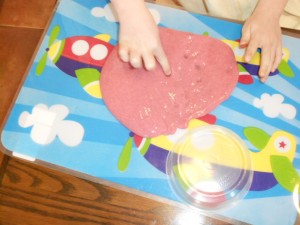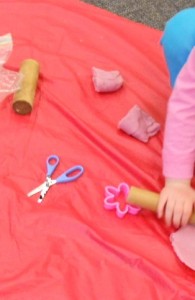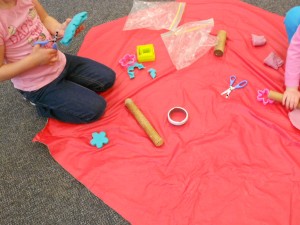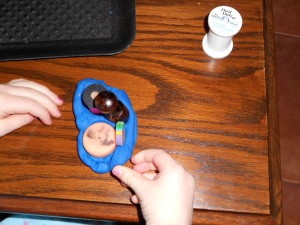 Sometimes the toys kids ask for most are the homemade ones, like playdough and slime; while these are inexpensive to make they are valuable in fun and learning. Big Sister asked for some this week. Unfortunately, we’d used up the red food coloring at Christmas but we had some lovely cinnamon hearts.
Sometimes the toys kids ask for most are the homemade ones, like playdough and slime; while these are inexpensive to make they are valuable in fun and learning. Big Sister asked for some this week. Unfortunately, we’d used up the red food coloring at Christmas but we had some lovely cinnamon hearts.
To make slime, first mix 1/2 cup of warm water and 1/2 cup of white glue. We popped several of the candy hearts into the warm water and waited for them to turn the water a lovely red. Most of the hearts melted leaving only a little bit of the candy center to take out. When we added the glue, the red water became light pink.
In a second bowl, mix 1 teaspoon of borax and 1 whole cup of warm water. Get ready for the next part, which changes very fast! Now, pour the gluey stuff into the clear water/borax and stir. Right away, the two solutions combine to make a polymer. There will likely be some extra water in the bowl which you can just pour off, leaving the wonderful goo.
As kids play with slime and playdough, they are developing:
- fine motor dexterity and strength, and hand-eye coordination,
- the ability to visualize, that is making pictures or images in the mind,
- language skills, such as vocabulary and descriptive language to talk about what’s happening,
- some basic math strategies like measuring and counting,
- their senses, especially the sense of touch as they learn to discriminate texture, temperature, and size,
- higher level thinking skills, such as planning, problem-solving, imagining and creating.
 Children are using more than their hands to play. They are also expressing themselves and how they feel. Playdough or slime can help children release pent-up emotions and tensions. The world isn’t always a friendly place for kids, and with these materials, they can feel more in control. Slime adds an unexpected element, because it’s so much more flexible. Even though this can be a little bit frustrating, it’s also exciting. Kids soon learn that cookie cutters will not work with slime, like they do with playdough.
Children are using more than their hands to play. They are also expressing themselves and how they feel. Playdough or slime can help children release pent-up emotions and tensions. The world isn’t always a friendly place for kids, and with these materials, they can feel more in control. Slime adds an unexpected element, because it’s so much more flexible. Even though this can be a little bit frustrating, it’s also exciting. Kids soon learn that cookie cutters will not work with slime, like they do with playdough.
Using either one, can you and your child squeeze some fun and learning into your day?


